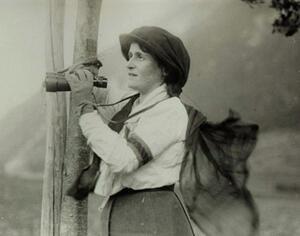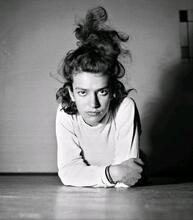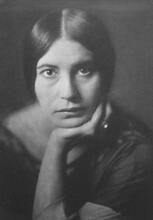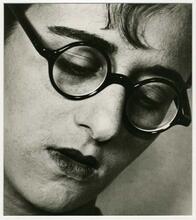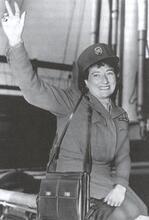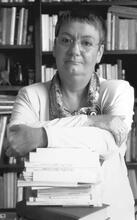Alice Schalek
Photojournalist and travel writer, Alice Schalek.
Courtesy of the Leo Baeck Institute.
Alice Schalek earned a reputation under her own name as writer and editor for the Neue Freie Presse from 1903 to 1934. She served on the board of the Association of Women Writers and Artists in Vienna and was the only female member of the Concordia organization for journalists and writers. In 1915 she joined the Austro-Hungarian War Information Office, travelling into war zones to photograph and report on the war. She wrote and lectured on her experiences and earned a Golden Cross for bravery from the Austrian government in 1917. She continued travel writing after the war, but in 1939 she was arrested by the Gestapo, after which she fled to New York and retired from journalism.
Early Life
The first woman in Austria to become a career photojournalist and travel writer, and the first and only female member of the Austrian Kriegspressedienst (war information unit) during World War I, Alice Schalek paved the way for careers in both photography and journalism for other women. Born in Vienna in 1874 to Jewish emigrants from Bohemia, Schalek first entered the public sphere at the turn of the century as the author of a well-received novel, published under the male pseudonym Paul Michaely.
Schalek’s early success in publishing was in no small part a result of her family’s connections to the burgeoning field of press and media; her father, Heinrich Schalek, successfully ran the first newspaper advertising agency in Austria, which her younger brother Norbert (1880–?) eventually took over. Schalek’s siblings also included an older brother, Rudolf (1869–1942), and a sister, Melanie. From 1903 to 1935 Schalek both wrote for and became an editor of the feuilleton section of the Neue Freie Presse under her own name and from 1904 to 1913 she wrote popular reports on her travels to Egypt, Palestine, India, Southeast Asia, Japan, and Australia, eventually publishing three books on the topic. In 1910 she held the first public lectures in Austria accompanied by photographs, and she also became the first woman to hold lectures at Vienna’s adult education center, Urania, in 1912.
Early Work
Though her family background certainly aided her early career in the media, it is less clear to what extent her Jewish identity directly influenced her work. Except for one newspaper essay in which Schalek admits that Jews as a group are often attacked despite their loyalty to the state, the majority of her reports do not mention Jewish issues. Schalek’s conversion to Protestantism in 1904 at the age of thirty, only one year after her appointment as editor at the Neue Freie Presse, suggests that career pressures and antisemitism led her to the change. Indeed, she was also exposed to antisemitism in the mountain climbing club Austria, in which she remained until its membership was restricted to Aryans in 1921. Schalek never married.
In addition to serving on the Board of the Association of Women Writers and Artists in Vienna, Schalek was the only female member of the Concordia organization for journalists and writers. Her early novels dealt not only with travel, but also with women’s themes, a subject that she would also portray in her travel photographs. Skilled at meeting important and influential people and fluent in numerous languages, Schalek also gained access to major political and cultural figures such as Albert Einstein (1879–1955), Mahatma Gandhi (1869–1948), George Bernard Shaw (1856–1950), and the Indian poet and Nobel prize winner Rabindranath Tagore (1861–1941). She was also friendly with Stefan Zweig (1881–1942), played tennis with Arthur Schnitzler (1862–1931), and corresponded with Marie von Ebner-Eschenbach (1830–1916). Before beginning her wartime journalism activities, she organized exhibitions and events in order to aid the war effort, for which she was honored by the mayor of Vienna with the Salvator-Medaille der Stadt Wien.
World War I
In 1915, Schalek became the first woman reporter in the Austro-Hungarian war information office. In comparison with those of trained photographers, Schalek’s style and technique were often amateurish. This was hardly surprising, since women had been allowed to take photography courses in Vienna only since 1908. Many of her photographs are unfocussed, and in numerous photographs the hands and feet of the subjects are cut off. However, unlike many of her male colleagues, she undertook dangerous journeys to the Tyrolean mountains, Serbia, and Galicia to interview soldiers and to take photographs. She not only wrote articles but upon her return also lectured on her experiences at the front, reaching audiences totaling tens of thousands. In recognition of her outstanding reporting during the war, the Austrian government in 1917 awarded Schalek the Goldene Verdienstkreuz mit der Krone am Bande der Tapferkeitsmedaille (Golden Cross with Crown on the ribbon of the medal for Bravery). However, others such as Karl Kraus (1874–1936) heavily criticized her war reporting for its glorification of bloody battles and brutality. Kraus, editor of the popular journal Die Fackel and one of the most influential journalists of the time, was also author of one of the most biting critiques of World War I in German literature. His much-admired and influential drama Die letzten Tage der Menschheit (The Last Days of Mankind), first published in 1919, satirizes many figures. However, Kraus reserved some of his most vitriolic attacks for Schalek, whom he considered the worst example of a warmongering journalist, even referring to her as a “hyena of the battlefield.” In 1916, Schalek filed a libel suit against Kraus for calling her, among other things, a “Jourjüdin” (Jewess-journalist). She withdrew her lawsuit in 1919, though by 1917 she had already been dismissed from the war information office as a result of Kraus’s attacks.
Postwar Life
After the war, Schalek resumed writing travel essays on countries in Asia, Africa, North and South America. In the interwar years her writing became more politically engaged and critical; focusing on championing the plight of underprivileged women, Schalek reported on events such as the newly formed women’s movement in Japan and the A voluntary collective community, mainly agricultural, in which there is no private wealth and which is responsible for all the needs of its members and their families.kibbutz system in Palestine. In addition to serving on the Board of the Viennese Association of Women Writers and Artists, through which she arranged for food shipments in the post-war years and raised funds through lectures, she also became a member of the Austrian branch of the American Business and Professional Women’s Club and the Soroptimist Club, evidence of her commitment to fostering the careers of women.
In 1939 Schalek was forced to stop working in Austria and was arrested by the Gestapo after they discovered photographs from a trip to Palestine in her apartment. Soon thereafter, Schalek went into exile in London and later New York, where she lived until her death in 1956. It is unclear to what extent she was able to continue her career after her arrival in the United States. However, her activity before 1939 shows that Schalek was an important contributor to journalism and photography. Despite the increase in antisemitism and misogyny which she faced in the interwar years, she was able to make substantial, lasting contributions to modern culture.
Selected Works
Under the pseudonym Paul Michaely:
Wann wird es tagen. Ein Wiener Roman. Vienna: 1902.
Das Fräulein. Vienna: 1905.
Under Alice Schalek:
Am Isonzo. März bis Juli 1916. Vienna: 1916.
An den Höfen der Maharadschas. Zürich: 1929.
Auf dem Touristendampfer. Vienna: 1905.
In Buddhas Land. Ein Bummel durch Hinterindien. Vienna: 1922.
Japan, das Land des Nebeneinander. Eine Winterreise durch Japan, Korea, und die Mandschurei. Breslau: 1925.
Indienbummel. Berlin: 1912.
Schmerzen der Jugend. Vienna: 1909.
Tirol im Waffen. Kriegsbericht von der Tiroler Front. Munich: 1915.
Auer, Anna and Kunsthalle Wien, eds. Übersee. Flucht und Emigration österreichischer Fotografen 1920–1940. Vienna: 1997.
Bachinger, Ursula. Alice Schalek. “Feministin (?), Kriegsberichterstatterin (?), Revolutionärin (?)” (thesis). Salzburg: Universität Salzburg, 1990.
Krasney, Elka, Marcus Patka, Christian Rapp, and Nadia Rapp-Wimberger. Von Samoa Zum Isonzo: Die Fotografin Und Reisejournalistin Alice Schalek. Vienna: 1999.
Klaus, Elisabeth. “Rehtoriken über Krieg: Karl Kraus gegen Alice Schalek.” Feministiche studien 26, Nr. 1 (2008): 65-82.
Mang, Ilse. “Solche Kontraste gibt's nur an der Front'. Die Kriegsberichterstatterin Alice Schalek im Kontext ihrer Zeit und und im Spiegel von Karl Kraus' Kritik” (thesis). Vienna: Universität Wien, 2009.
Wagener, Mary Louise. “Pioneer Journalistinnen, Two Early Twentieth-Century Viennese Cases: Berta Zuckerkandl and Alice Schalek.” Ph.D. diss., Ohio State University, 1976.

